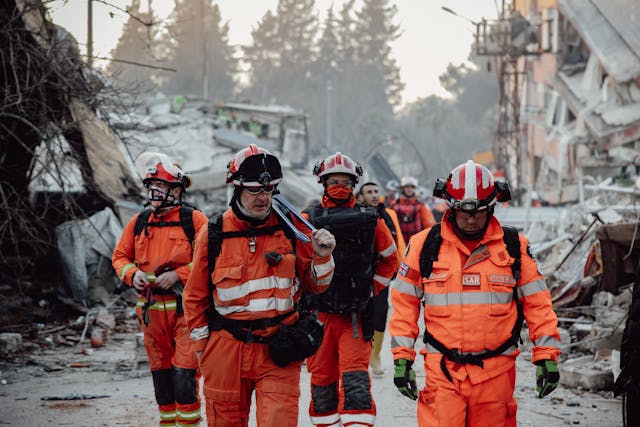Photo from Pexels
Unannounced natural disasters expose businesses to severe financial and operational losses. Earthquakes can destroy physical assets, sudden floods can submerge critical infrastructure, and hurricanes can dismantle supply chains within hours. Beyond immediate damage, these events often cause long-term disruptions that affect customer confidence, profitability, and production. Businesses unprepared for such disasters face prolonged downtime, irreversible data loss, and potential permanent closure. Building resilience requires more than reactive measures; proactive safeguarding ensures continuity, protects valuable assets, and enables swift recovery. A comprehensive protection strategy focuses on strengthening infrastructure, enhancing digital and physical security, and ensuring all operational aspects can withstand unexpected events. Long-term stability depends on continuous preparation and a clear understanding of the risks posed by natural disasters.
Building Structures Against Natural Forces
The physical layout is a company’s first natural disaster defense. A building that can’t withstand environmental stress damages everything inside. Continuous operations during unexpected events require careful planning and investment in advanced physical infrastructure protection. Construction to the most current safety standards increases storm resistance. Stronger walls increase flood and earthquake resistance, raised foundations, and shock-absorbing materials. By strengthening older buildings against earthquakes and storms, modern reinforcements reduce structural risk. To reduce damage, keep data servers and electrical systems in disaster-resistant areas. Buying alternative energy and backup systems allows operations if public utilities fail. On-site generators, renewable energy, and extra water meet emergency needs. Regular inspections and asset maintenance ensure long-term protection. Businesses that prioritize their infrastructure can survive and recover from extreme natural disasters.
Adopting Plans for Comprehensive Disaster Recovery
Maintaining business operations during and after a natural disaster relies heavily on a robust IT disaster recovery system. The system includes real-time data replication across multiple secure, geographically dispersed data centers to ensure that the data remains accessible even if one facility is compromised. Automated recovery systems enable fast restores, minimizing downtime and financial losses. Encryption protects sensitive data during storage and transmission, while regular disaster recovery exercises identify system flaws and improve response capabilities. Employee training in emergency protocols and well-documented recovery procedures further ensure a swift, efficient return to normal operations, allowing businesses to continue offering uninterrupted services.
Developing Crisis Situation Communication Systems
Organizing response activities and ensuring employee and stakeholder safety during natural disasters depends on effective communication. Disturbed communication channels cause uncertainty, postpone critical decisions, and compromise recovery efforts. Effective communication systems maintain contact during crises using several channels. With satellite phones, safe messaging apps, and emergency alert systems, constant access to vital information comes. Even in cases of physical office locations being inaccessible, real-time collaboration made possible by cloud-based communication tools helps.
Specific emergency hotlines enable staff members and partners to report problems and obtain updates. Choosing communication leaders helps to guarantee the quick sharing of accurate information. These people forward updates to outside partners, coordinate with emergency services, and schedule internal communications. Well-defined messaging systems support consistent responses and help reduce false information. Regular communication during a disaster speeds up recovery efforts and helps keep operations under control.
Distributing Supply Chains to Reduce Operating Risk
Natural disasters can damage manufacturing facilities, disrupt supply chains, and cut off transportation routes, increasing operational risks. Over-reliance on a single supplier or location heightens vulnerability during such events. To build a resilient supply chain, companies should diversify their vendors across multiple locations, ensuring that alternative sources continue to provide goods and services during localized disruptions. Secondary manufacturing sites and contracts with various logistics providers help maintain production and adaptable delivery routes. Real-time tracking systems offer early warnings and enable proactive procurement adjustments. Regular reviews of supplier contracts and backup plans help protect against unexpected risks, allowing companies to maintain operational flow and reduce financial impacts.
Ensuring Financial Resilience Using Emergency Plans
The degree of financial readiness of a company will determine whether it can keep running both during and after a natural disaster. Continuous disruptions may compromise long-term viability without emergency funds, leading to a shortfall in recovery programs. Establishing a dedicated emergency fund provides quick liquidity for covering repairs and temporary accommodation to ensure that these, among other regular costs, are covered. This financial cushion ensures that the business runs even in cases of limited outside resources.
Complete business interruption insurance protects income lost through an operational shutdown. The policies are specifically designed to address industry-specific hazards and provide coverage for both physical and digital losses. Keeping open financial records guarantees regulatory compliance and streamlines the claims procedure. During a crisis, pre-approved credit lines created by working with financial institutions greatly increase liquidity. Businesses that give financial resilience first importance will be able to weather unforeseen circumstances and maintain stability and future growth.
Conclusion
Natural disaster strikes depend on proactive planning and strategic investment to let operations go on. Physical infrastructure is being strengthened, disaster recovery systems are being made comprehensive, communication networks are kept clear, supply chains are diversified, and financial resilience is guaranteed to defend strongly against unanticipated events. Businesses with these defenses are better suited to protect assets, maintain customer trust, and continue to expand even under the toughest circumstances.

